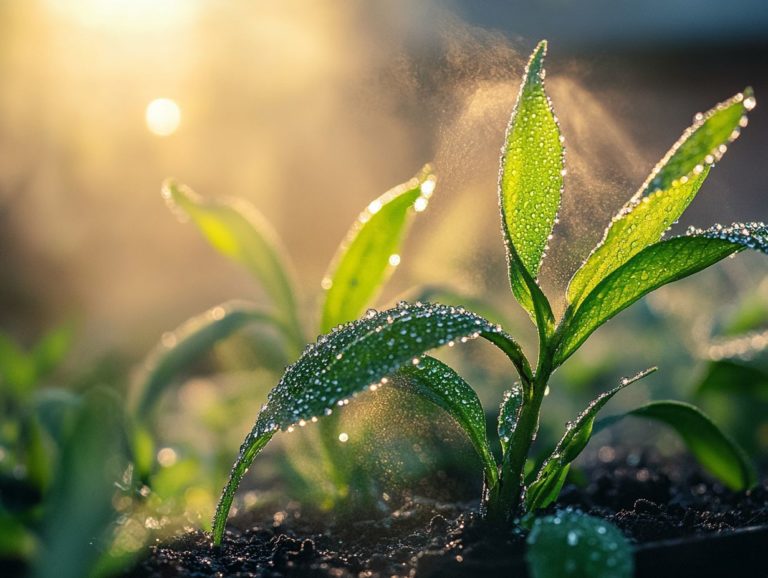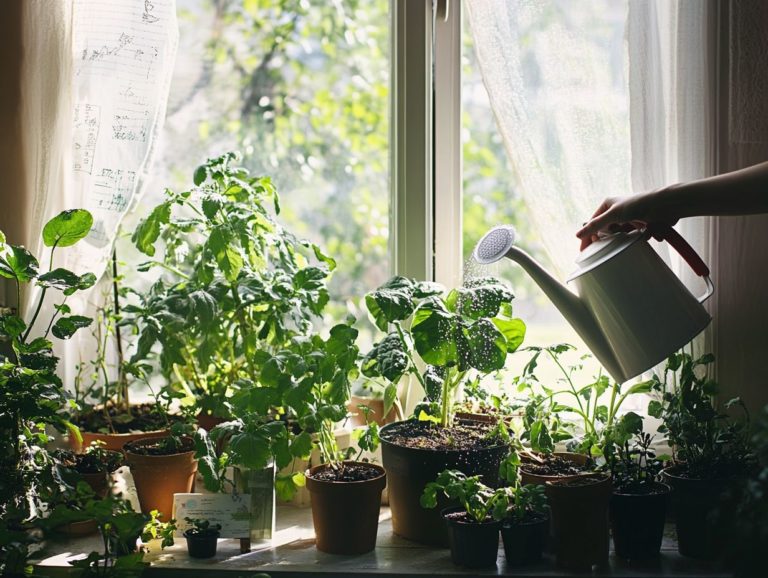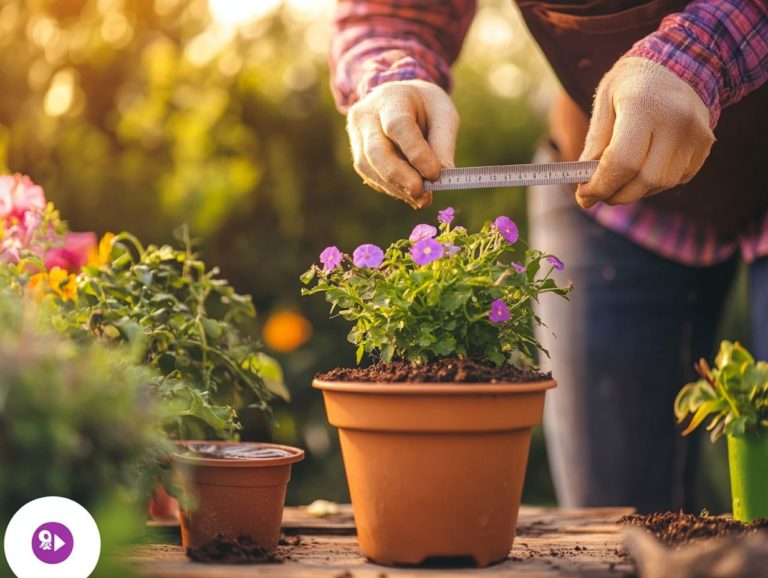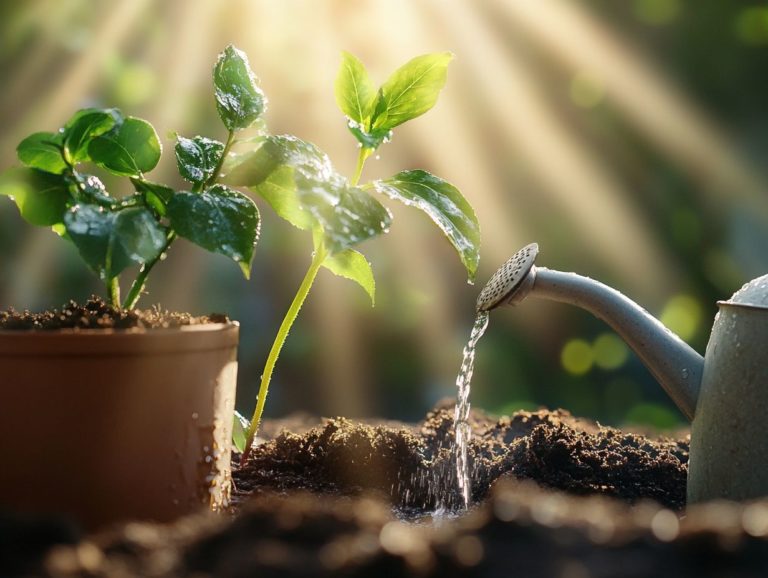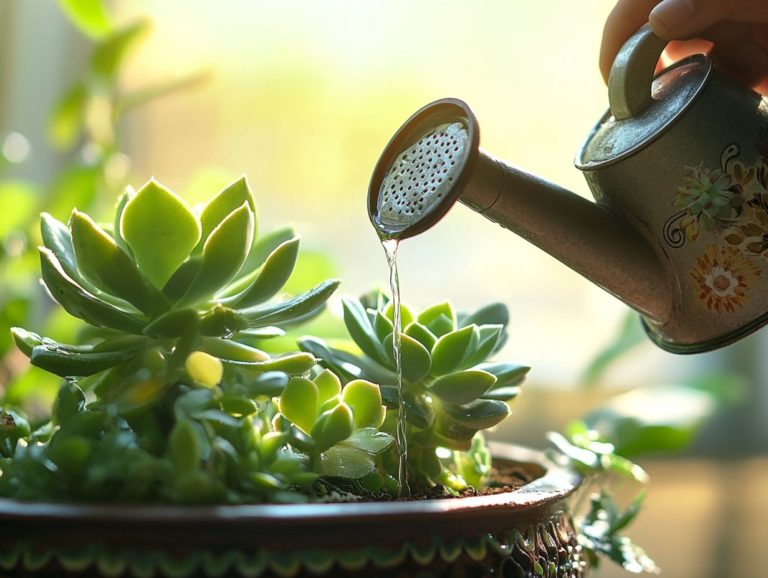How to Use a Watering Gauge for Indoor Plants
Proper watering is essential for keeping your indoor plants healthy and vibrant. Both over-watering and under-watering can challenge plant owners, leading to issues like root rot and stunted growth.
To help you navigate this delicate balance, let’s explore the role of watering gauges handy gardening tools that eliminate the guesswork around moisture levels. You’ll discover different types, learn how to use them effectively, and find alternative methods to ensure your plants thrive in any outdoor environment.
Dive in to uncover tips and insights that will elevate your indoor gardening experience and boost your gardening confidence!
Contents
- Key Takeaways:
- The Importance of Proper Watering for Indoor Plants
- What is a Watering Gauge?
- Types of Watering Gauges
- How to Use a Watering Gauge for Indoor Plants
- Tips for Using a Watering Gauge Effectively
- Other Ways to Check Soil Moisture
- Frequently Asked Questions
- What is a watering gauge and why is it important for indoor plants?
- How do I use a watering gauge for my indoor plants?
- How often should I check the moisture level of my indoor plants using a watering gauge?
- Can I use a watering gauge for all types of indoor plants?
- Is it necessary to have a watering gauge for my indoor plants?
- Can I use a watering gauge for outdoor plants as well?
Key Takeaways:

- Proper watering is crucial for healthy indoor plants, as both over and under-watering can have negative effects.
- A watering gauge, or soil moisture meter, is a device that measures soil moisture levels, helping to prevent over or under-watering.
- To use a watering gauge, insert the probe into the soil and adjust watering based on the reading, while also considering factors like plant type, moisture level, and light conditions.
The Importance of Proper Watering for Indoor Plants
Proper watering is essential for the health and survival of your indoor plants, ensuring they thrive in their unique environments. Each plant species, like succulents and the African milk tree, has different needs. Using a soil moisture meter helps you create a good watering schedule, preventing common pitfalls like overwatering or under-watering, which can jeopardize plant growth.
By grasping moisture levels, light conditions, and specific requirements of different plant varieties, you can cultivate an indoor garden that flourishes, ultimately enhancing your gardening experience and boosting your confidence.
Effects of Over and Under-Watering
Overwatering and under-watering can dramatically affect your plants’ health. Identifying the ideal moisture level is crucial for maintaining a thriving indoor garden. Both overwatered and underwatered plants display symptoms that can confuse even the most well-intentioned plant parents.
It s essential to recognize the alarming signs of overwatering: yellowing leaves that feel soft and mushy, signaling rot, along with soil that looks waterlogged and emits an unpleasant odor. Conversely, an underwatered plant will reveal its distress through wilting, giving off a lifeless vibe and developing crispy edges on leaves classic signs of dehydration, indicative of a watering routine gone awry.
By understanding these symptoms, you can refine your watering practices, sidestepping the pitfalls of too much or too little moisture. This knowledge gives you the ability to care for your green companions effectively, ensuring not just their longevity but also a vibrant and healthy appearance, akin to the thriving Bird of Paradise or fiddle leaf fig.
What is a Watering Gauge?
A watering gauge, commonly known as a soil moisture meter, is an essential tool for your plant care routine. It allows you to check the moisture content in your soil, enabling you to make informed decisions about how often to water.
This simple tool can transform your plant care routine! It’s especially valuable for those who want to sidestep the common traps of overwatering and under-watering, ensuring that your plants remain healthy and vibrant in both indoor and outdoor environments, enhancing your overall gardening experience.
With the right tools and knowledge, your plants will thrive and bring joy to your space! Start measuring your soil moisture today for healthier plants!
Definition and Function
A watering gauge, also known as a soil moisture meter, is an essential tool for measuring the moisture level in soil. It offers critical insights that help you improve your plant care. By simply inserting this handy gardening tool into the soil, you can easily determine whether your plants need water or if the moisture levels are adequate, thereby enhancing your plant health.
This effective tool uses a series of probes to assess water content by measuring the soil’s conductivity. Conductivity refers to how well the soil allows electricity to flow, which helps gauge moisture. When moisture is present, resistance drops, allowing the gauge to provide an accurate reading crucial for your watering schedule.
Understanding soil moisture levels can transform your gardening success. It allows you to make informed irrigation decisions, preventing the pitfalls of overwatering and underwatering that can lead to root rot or drought stress. Incorporating such tools into your gardening routine enhances the health and resilience of your plants, promoting optimal growth conditions and ensuring that each species, from succulents to tropical plants, flourishes beautifully in its environment.
Types of Watering Gauges

You ll find various watering gauges designed for gardeners who want to monitor soil moisture precisely, reducing common mistakes in plant care. These tools range from simple analog models to advanced digital soil moisture meters that use electrical currents for accurate readings, appealing to both novice and experienced plant owners.
Whether you re nurturing moisture-loving plants or a variety of others, there s a gauge perfectly suited to your gardening requirements.
Comparison and Uses
When evaluating various watering gauges, consider their specific uses and how they meet different gardening needs based on plant types, such as candelabra cactus or pothos, and watering frequency. Some soil moisture meters are designed for specific care routines, making them essential for both indoor and outdoor gardening enthusiasts.
Each type of watering gauge has its own set of advantages and drawbacks. For example, analog gauges provide a simple moisture reading but may lack the precision found in digital models, which often deliver detailed insights for optimal watering.
Understanding how these tools work enables you to choose the gauge that best suits your plant species whether it s succulents that thrive on infrequent watering or tropical plants that crave moisture.
By selecting a watering gauge that matches each plant’s unique needs, you can develop a more effective watering strategy. This ultimately promotes healthier growth and enhances your garden management skills across various plant types.
How to Use a Watering Gauge for Indoor Plants
Utilizing a watering gauge, or soil moisture meter, is a straightforward practice that can significantly elevate your plant care routine. It offers precise insights into your plants’ hydration requirements and pH levels.
Follow these step-by-step instructions to effectively monitor soil moisture levels. This will enable you to establish an optimal watering regimen for your indoor plants, enhancing your overall gardening experience.
Step-by-Step Instructions
To effectively use a watering gauge, begin by inserting the probe into the soil at the area where a plant s roots are located, ensuring it makes good contact for accurate moisture readings. This straightforward step sets the stage for your gardening tool to offer insights that can greatly enhance your plant care routine.
Once the probe is firmly in place, patiently await the device to display a reading. This will aid in determining your plants’ watering needs. Most gauges feature a scale indicating moisture levels, which range from dry to wet. This allows you to avoid over-saturation and maintain happy plants. For more insights on how to properly care for your plants, understanding the science of watering indoor plants is crucial. If the gauge points to the dry zone, it’s time to give your plants a drink, which is essential for maintaining their health. Conversely, if it shows moisture in the moderate to wet zones, it’s best to hold off on watering to prevent over-saturation, which can lead to waterlogged soil and root-bound conditions.
Understanding moisture levels is crucial. It ensures your plants get the hydration they need and helps avoid common mistakes in plant care. Regular monitoring allows you to make adjustments tailored to your plants’ specific needs, fostering growth and resilience.
Remember, different plant types, pot sizes, and environments affect soil moisture, so staying attentive is essential for effective plant management.
Tips for Using a Watering Gauge Effectively
To truly maximize the effectiveness of your watering gauge, it’s essential to master the art of interpreting readings from your moisture gauge with precision, understanding how these readings relate to your plants’ specific moisture needs. Establishing a consistent watering rhythm that aligns with the unique needs of your plants, such as the hydration preferences of the African milk tree and candelabra cactus, will elevate your gardening game.
By implementing these strategies, you’ll see a remarkable improvement in maintaining optimal plant health, transforming you into a confident plant parent.
Maximizing Accuracy and Efficiency
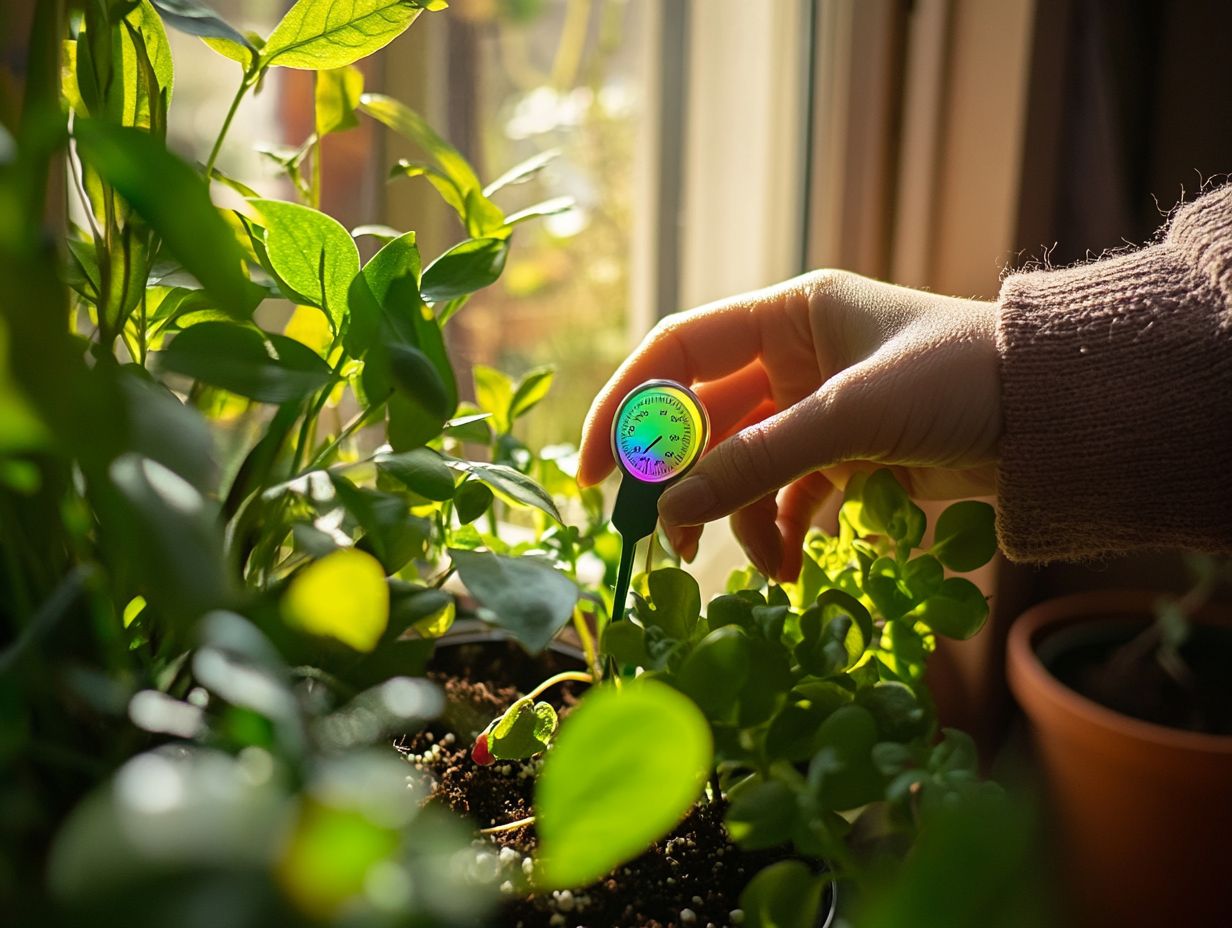
To ensure accurate readings from your watering gauge, calibrate the device as needed and explore the nuances of soil properties that affect moisture levels. This will further enhance your gardening skills. With proper calibration and care, you can elevate your plant care strategies and gardening tips to new heights.
Understanding specific soil types is important for moisture retention, which ultimately influences plant health. Sandy soils drain quickly, while clay retains water; knowing this helps you decide when to water your plants. Regularly monitoring these conditions allows you to adjust your watering schedule, striking the perfect balance to prevent both overwatering and underwatering, ultimately sustaining your plants’ health.
Employing techniques like digging a small hole to check moisture levels can offer valuable insights, especially when considering the pH test for optimal plant care. By embracing these best practices, you ll navigate the complexities of plant hydration with finesse, ensuring your green companions thrive beautifully throughout the seasons and grow to their full potential.
Other Ways to Check Soil Moisture
Along with utilizing a watering gauge, you have a variety of alternative methods at your disposal for assessing soil moisture. These can greatly enhance your plant care routine especially for those moisture-loving varieties like the ZZ plants and pothos.
These techniques range from straightforward DIY solutions to specialized gardening tools, all designed to help you deliver the perfect amount of water to your indoor garden.
DIY Solutions and Other Tools
DIY solutions for checking soil moisture can be as simple as using a wooden dowel or even your finger to gauge moisture levels. These quick and inexpensive alternatives can significantly enhance your understanding of your plants’ watering needs, promoting their overall survival.
Consider incorporating a soil moisture meter into your toolkit. This low-tech yet effective gadget allows you to obtain precise readings, helping you identify the exact moisture levels in various plant beds and pots.
By integrating these methods into your regular plant care routine, you not only save time but also effectively prevent problems with giving too much or too little water. You can enhance your garden’s health by using tools like:
- Mulch to retain moisture
- Moisture-retentive pots
With these DIY techniques and complementary tools, you can optimize your plant care regimen, ensuring robust growth and vibrant greenery.
Frequently Asked Questions
What is a watering gauge and why is it important for indoor plants?
A watering gauge is a tool used to measure the amount of water in the soil of your indoor plants. It is important because over or under watering can be harmful to your plants. The gauge helps ensure that your plants are receiving the appropriate amount of water.
How do I use a watering gauge for my indoor plants?

Start by inserting the gauge into the soil near the base of the plant. Pull it out slowly and observe the markings on the gauge. These markings indicate the moisture level of the soil. Based on the reading, you can determine if your plant needs to be watered or not.
How often should I check the moisture level of my indoor plants using a watering gauge?
This may vary depending on the type of plant and its water needs. However, it is recommended to check the moisture level of your plants at least once a week. This will ensure that your plants are receiving the proper amount of water and prevent over or under watering.
Can I use a watering gauge for all types of indoor plants?
Yes, a watering gauge can be used for a variety of indoor plants. However, it is important to note that different plants have different water needs. It is best to research the specific water requirements for each of your plants and adjust your watering schedule accordingly.
Is it necessary to have a watering gauge for my indoor plants?
While a watering gauge isn’t required, it can be a game changer for keeping your plants healthy! It provides a more accurate measurement of the soil’s moisture level compared to just relying on visual cues or finger testing.
Can I use a watering gauge for outdoor plants as well?
Yes, a watering gauge can also be used for outdoor plants. It is a helpful tool for all types of plants, whether they are grown indoors or outdoors. Just make sure to adjust your watering schedule to accommodate the different water needs of outdoor plants.
Start using these simple tools today and watch your indoor garden thrive!

